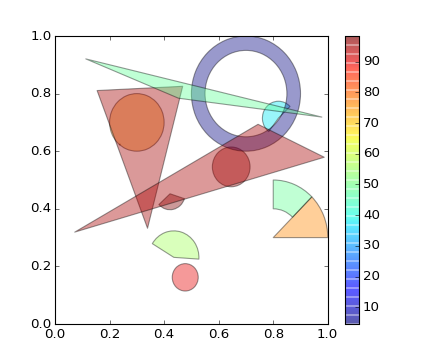
Learn what to expect in the new updates

(Source code, png, hires.png, pdf)

import numpy as np
import matplotlib
from matplotlib.patches import Circle, Wedge, Polygon
from matplotlib.collections import PatchCollection
import matplotlib.pyplot as plt
fig, ax = plt.subplots()
resolution = 50 # the number of vertices
N = 3
x = np.random.rand(N)
y = np.random.rand(N)
radii = 0.1*np.random.rand(N)
patches = []
for x1,y1,r in zip(x, y, radii):
circle = Circle((x1,y1), r)
patches.append(circle)
x = np.random.rand(N)
y = np.random.rand(N)
radii = 0.1*np.random.rand(N)
theta1 = 360.0*np.random.rand(N)
theta2 = 360.0*np.random.rand(N)
for x1,y1,r,t1,t2 in zip(x, y, radii, theta1, theta2):
wedge = Wedge((x1,y1), r, t1, t2)
patches.append(wedge)
# Some limiting conditions on Wedge
patches += [
Wedge((.3,.7), .1, 0, 360), # Full circle
Wedge((.7,.8), .2, 0, 360, width=0.05), # Full ring
Wedge((.8,.3), .2, 0, 45), # Full sector
Wedge((.8,.3), .2, 45, 90, width=0.10), # Ring sector
]
for i in range(N):
polygon = Polygon(np.random.rand(N,2), True)
patches.append(polygon)
colors = 100*np.random.rand(len(patches))
p = PatchCollection(patches, cmap=matplotlib.cm.jet, alpha=0.4)
p.set_array(np.array(colors))
ax.add_collection(p)
plt.colorbar(p)
plt.show()
Keywords: python, matplotlib, pylab, example, codex (see Search examples)